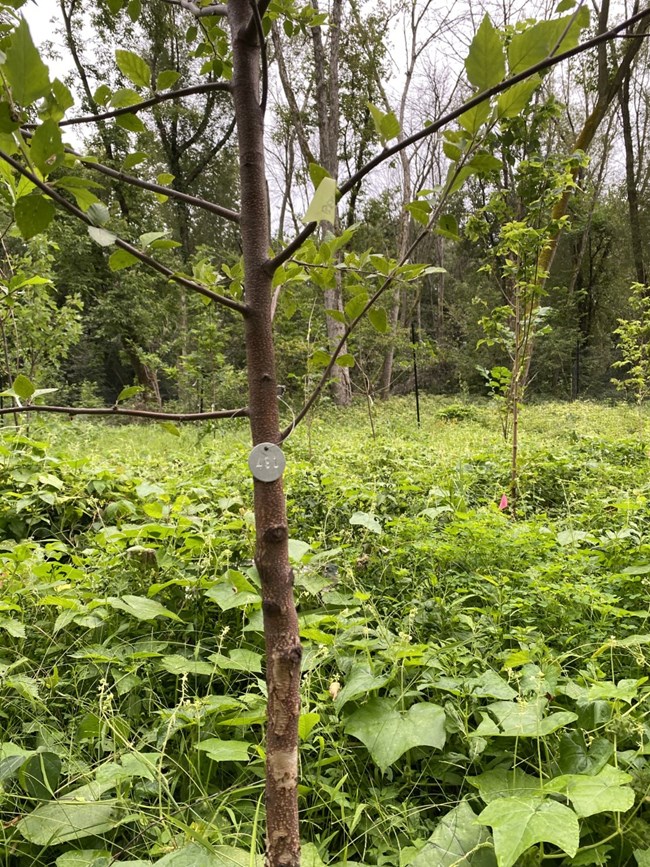Last updated: March 3, 2021
Article
Tracking Change and Growth at Crosby Farm

Mississippi Park Connection
Ash trees are prevalent throughout the floodplain forests of the Mississippi National River and Recreation Area, where they compose an estimated 20-40% of the park’s canopy. But within the next few years, more than one million of these trees are expected to succumb to the emerald ash borer—an invasive beetle that has already transformed forests in the Northeast, and is now creeping deeper into the Midwest. Within Crosby Farm Regional Park, St. Paul’s largest natural park, indicators of a changing ecosystem are etched onto the bark of ash that have been rendered skeletal and blond by woodpeckers that remove the outer bark in search of beetle larvae burrowed in the soft wood. Ensuing decay and deadfall have left significant gaps in Crosby Farm’s canopy.
But, if you hike into the park today, you might notice that some of these gaps are beginning to fill back in—not with invasive plants as might be expected, but with a diverse variety of trees, each marked with a silver tag. The trees are part of the Adaptive Silviculture for Climate Change (ASCC) project, a nation-wide experiment aimed at preparing forests for the impacts of climate change. Ranging from New Hampshire’s hardwood forests to Colorado’s towering pines and firs, each study site tests a different climate adaptation strategy. The experiment at Crosby Farm considers how different tree species will weather the warming temperatures and more severe flooding events projected for the region.
The project took root in May 2020 when, in the midst of the pandemic, more than 300 volunteers came together—in shifts and at a distance—to plant 1,200 trees across 24 study plots. Today, we are happy to report that Marcella Windmuller-Campione, a research scientist in silviculture at the University of Minnesota, and her team has found that 86.5% of these trees have survived—an astounding figure if you consider where many of these new trees come from.
Some of the species—like cottonwoods, hackberry, and river birch—are familiar friends of the floodplain forest. Others, however, are more often found further down the Mississippi River, and include species uncommon to Minnesota like American sycamores, southern pin oaks, and yellow poplars. Each of the 14 species included in the study was carefully selected by a group of 30 floodplain forestry experts with the knowledge that southern Minnesota’s winters will resemble those of present-day northern Illinois by the end of the century.
Because this transition is inevitable, it can feel overwhelming and out of our hands. But beyond ASCC’s scientific importance, the study also offers an immaterial hope: that, in the face of this dramatic shift, proactive adaptive responses—like, say, encouraging a diverse canopy and genetic composition—can help forests weather the changes and diseases to come.
Thanks to the contributions of park volunteers Chelsey Shoup and Ed Heimel, who have ventured to the park every month to take photographs at each site, we have been able to track the progress of these trees over the summer and fall. Their photographs allow us to take a step back and witness these trees become established in this critical first year of the study. Take, for instance, the above gif. At the center of each image stands an American sycamore, a versatile tree with a habitat range that stretches to the wetlands of the Southeast. The species has largely thrived at Crosby Farm; look around at your feet when you visit these plots, and you just might find a sycamore leaf larger than your head.
The sycamore’s growth is matched by that of the silver maple, which towers over many of the study’s other trees. While the silver maple is native to the Midwest and currently found throughout the Metro area, researchers are concerned with the species’ ability to regenerate naturally. For that reason, the study introduces southern genotypes of the silver maple—varieties from Iowa and Missouri that might be able to better establish themselves. Though the silver maples pictured below appear to be thriving, we will continue to monitor their growth closely over the course of this twenty-year study.
Chelsey and Ed’s chronological photographs remind us that change is imminent—not just the existential transformations that climate change imposes, but the seasonal variations that, at least for the time being, remain a signature of Minnesota. In a year marked by taking it one day at a time, there is something about witnessing these seasonal shifts at Crosby Farm that provides a counterpoint, demonstrating that these cycles will continue even while so much else seems stalled. We hope these photos—and that impressive 86.5% survival rate!—give you reason to celebrate as we conclude this trying year and venture into a new, undetermined one
By Mike Curran, 2020-21 Minnesota GreenCorps Member
